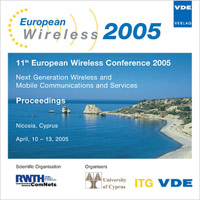Classes of Nodes with Different Power Amplifiers and their Influence in Wireless Multi-hop Networks
Konferenz: European Wireless 2005 - 11th European Wireless Conference 2005 - Next Generation wireless and Mobile Communications and Services
10.04.2006 - 13.04.2005 in Nicosia, Cyprus
Tagungsband: European Wireless 2005
Seiten: 7Sprache: EnglischTyp: PDF
Persönliche VDE-Mitglieder erhalten auf diesen Artikel 10% Rabatt
Autoren:
Kubisch, Martin; Karl, Holger; Wolisz, Adam (Telecommunication Networks Group, Technische Universität Berlin, Germany)
Inhalt:
Optimizing wireless network operations can be achieved by transmission power control of wireless nodes, which is mostly performed by regulating the final power amplifier. Depending on the desired transmission power level, currently popular amplifiers work at different levels of efficiency: highest in case of maximum output power, lower in case of reduced output power. As the power amplifier is the major power sink in most common network interfaces, operating at high efficiency is desirable. Ideally, a node would operate using a power amplifier which is tuned to provide its highest efficiency at the node’s (single or typically used) transmission power level. Our idea is to use specialization of nodes to allow for efficient short-range communication using (mostly) ”short-range” specialists – nodes where the power amplifier is optimized for low output power values – and to use the corresponding ”long-range specialists” for the long-distance communication in one network. However, the node deployment strategy should stay the same and all nodes have to be able to provide all power levels, albeit at different costs. We discuss the implementation and performance characteristics of such heterogenous networks in this paper. The results show a potential reduction in energy consumption to less than 65 % compared to classical networks with uniform amplifiers. We characterize the optimum ratio of nonheterogenous nodes for a given network density with different types of node distributions and show how missing the optimum ratio will impact the energy consumption of the network.


